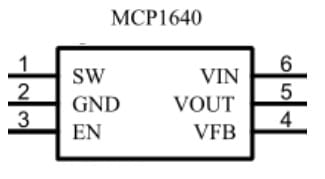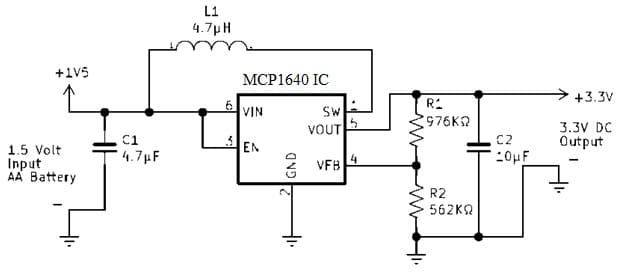A synchronous step-up DC to DC-converter is an integrated circuit that enhances voltage supply from an input to an output. So this type of SMPS (switched-mode power supply) utilizes a minimum of two semiconductors like a transistor, a diode, and a single energy storage element. These converters are more efficient than nonsynchronous converters including 95% optimal operation efficiencies. The applications of this converter involve powering natural LED panels, charging white LED backlights, holsters, USB power supplies, camera flash LED drivers, etc. Thus, the examples of synchronous step-up DC-DC converters are; ST8R00, MCP1640, LTC3525D-3.3, LM4510, etc. This article elaborates on the MCP1640 IC, pinout, features, specifications & its uses.
What is MCP1640 IC?
The MCP1640 is a compact, fixed frequency, high-efficiency, and synchronous step-up DC to DC converter chip. So this IC provides an accessible power supply solution mainly for applications, powered through single-cell, two-cell, otherwise three-cell alkaline, NiMH, NiCd, one-cell Li-Ion (or) Li-Polymer batteries. The MCP1640 IC is a 0.65Volts start-up synchronous boost regulator including a true input/output bypass or output disconnects option.
So this regulator uses low-voltage technology to set up without high inrush current (or) output voltage overshoot from low input voltage. This converter IC provides extremely high efficiency by adding the low resistance-based N-channel boost switch & synchronous P-channel switch. Thus, all protection and compensation circuitry is incorporated to reduce the number of exterior components.
How MCP1640 IC Works?
The MCP1640 DC-DC converter IC works by incorporating a low resistance N-Channel Boost switch & a synchronous P-Channel switch to attain high efficiency. So, this is a synchronous boost regulator chip from Microchip Technology that provides a power supply for different applications that utilize batteries: This compact and high-efficiency DC-DC converter IC automatically chooses between PWM or PFM modes for efficiency. So, it has 0.65V of low start-up voltage & 0.35 to 5.5V wide input voltage range.
MCP1640 IC Pin Configuration:
The MCP1640 IC pin configuration is shown below. So this IC includes six pins which are explained below.

MCP1640 IC Pin Configuration
- Pin-1 (SW): This is the switch node pin of IC that carries an inductor current that reaches 800 mA of peak current. So a logic low must be provided to this pin to disable the regulator IC.
- Pin-2 (GND): It is a ground pin of IC.
- Pin-3 (EN): This is an enable pin of the IC with various functions based on the device series.
- Pin-4 (VFB): This pin provides output voltage regulation with a resistor divider.
- Pin-5 (VOUT): It is an output pin of IC.
- Pin-6 (VIN): It is an input voltage pin of the IC.
Features & Specifications:
The features and specifications of MCP1640 IC include the following.
- MCP1640 IC is a synchronous boost regulator & DC-DC converter.
- This regulator was manufactured by microchip technology.
- This IC includes 6 pins and is available in the SOT package.
- The MCP1640 IC start-ups exclusive of high inrush current (or) output voltage overshoot from 0.65V low input.
- This IC’s typical efficiency is up to 96%.
- It consumes 19 µA of power only when it operates at no load.
- This IC provides a true disconnect when in Shutdown from input to output.
- Its adjustable output voltage ranges from 2.0V to 5.5V.
- Its typical peak input current limit is 800 mA
- This IC start-up voltage is low 65 V and the typical VOUT at 1 mA is 3.3 V.
- PWM operation is 500 kHz/
- The operating input voltage is low like 35 V.
Equivalents & Alternatives :
Equivalent of MCP1640 ICs are; MCP1640DT-I/MC, MCP1640T-I-CHY, MCP1640BT-I/CHY, MCP1640B-I/MC, etc. So, alternative MCP1640 ICs are; XL4001, LM2576D2TR4-5, R1SE-0505-R, TSRN 1-2433, LM2678T, TPS61200DRCT, LM5020SD-1, SG3524N, LTC3114EFE, LM2576-5, etc.
1.5V to 3.3V Converter Circuit with MCP1640 IC
Generally, AAA size or AA Size 1.5V battery is used in everyday life. Here, a boost converter circuit is designed to boost 1.5Votls DC supply to 3.3V DC supply with MCP1640 IC from a microchip using a few elements.
So, the MCP1640 IC is a compact, fixed-frequency, and high-efficiency-based DC-to-DC converter chip. This IC can be utilized as a single-cell (or) dual-cell battery power supply solution. So this IC provides 100mA current and 3.3V output voltage by the 1.5V input voltage supply. It can also provide 350mA current and 3.3V Vout with the 2.4 Volt input voltage supply. Thus, MCP1640 IC’s operating voltage is very low at 0.35V and the usual 3.3 Vout at 1 mA.
The required components to make this 1.5V to 3.3V converter circuit mainly include MCP1640 IC, resistors like; 976KΩ & 562KΩ, capacitors like 4.7µF & 10µF, 4.7µH inductor, and J1 screw terminal. So, connect this simple circuit as per the diagram shown below.

1.5V to 3.3V Converter Circuit with MCP1640 IC
Working
This converter circuit is mainly designed to increase voltage from 1.5V to 3.3V. So this circuit receives a 1.5V supply to the Vin pin and the C1 capacitor in the circuit performs filtering operation for input supply. The L1 Inductor is connected between Vin & SW pins and R1 and R2 resistors are fixed values because of the fixed frequency function of IC. Here, a 3.3V output supply can be received from the Vout pin of the IC. So finally we can get a 3.3 volt output supply at 100mA current. This converter circuit with MCP1640 IC can be used within 1.5Volts battery-powered applications and IOT sensors.
Advantages & Disadvantages
The advantages of MCP1640 IC include the following.
- It regulates the output voltage above a wide range of 2.0V to 5.5V.
- This IC can deliver above 100 mA of load current at 3.3 volts output.
- It operates at the minimum input voltage required to drain the battery completely.
- It increases battery life.
- This is a compact, fixed frequency, high-efficiency, and synchronous step-up DC to DC converter IC.
The disadvantages of MCP1640 IC include the following.
- The bad GND connection of this IC causes different issues, even overvoltage that may harm the device.
- This IC will not begin into heavy load.
- These converter ICs can cause switching noise, which can lead to malfunction.
- These ICs can be expensive.
- This IC can be more complex & have large sizes.
- It has wideband output noise which needs careful board layout & grounding schemes.
- They have poor light-load efficiency.
- It has a limited gain range.
Applications
The applications of MCP1640 IC include the following.
- It is used in portable products that use single, double (or) three-cell alkaline & NiMH or NiCd batteries.
- These are used in single-cell Li-Ion converters and Li coin cell-powered devices.
- It is used in personal medical products and for wireless sensors
- This IC is used to isolate OLED modules & their driver circuitry from low-power parts of the system.
- This IC is used in GPS receivers, handheld instruments, and Bluetooth headsets.
Please refer to this link for the MCP1640 IC Datasheet.
Thus, this is an overview of MCP1640 IC, which is a compact, synchronous, and high-efficiency step-up DC-DC converter: It is a power supply solution mainly for applications powered by NiCd, alkaline, NiMH, Li-Polymer or Li-Ion batteries. This IC has a low start-up voltage, wide input voltage range, and low quiescent current. Here is a question for you, what is LM2678 IC?